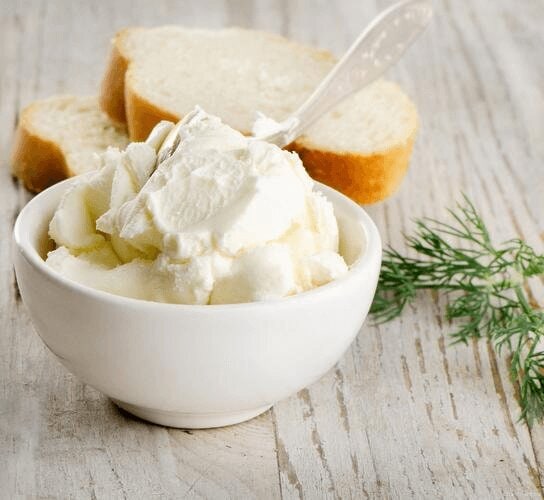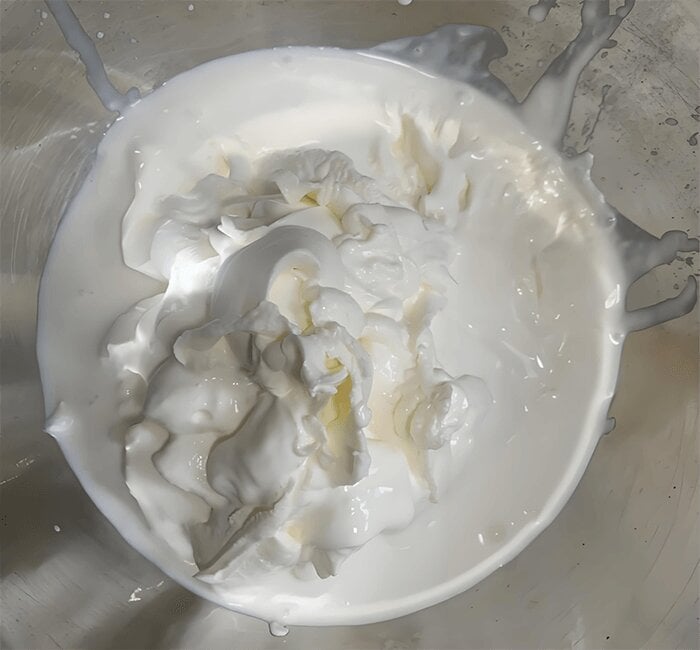powered by PiQR.io
powered by PiQR.io


Have you ever found yourself staring at the leftover homemade whipped cream after crafting the perfect dessert, wondering how to store it properly? How long can it last before going bad? What happens if you eat spoiled whipped cream?
The answer is that the shelf life of homemade whipped cream depends on storage conditions, the ingredients used, and how frequently the container is opened. Under refrigeration, it typically lasts 2 to 3 days. However, if you add fresh fruits or other perishable ingredients, the shelf life may be reduced to 1 to 2 days.
Curious to learn more about the finer details of storing homemade whipped cream and how to efficiently make perfect whipped cream using a cream dispenser? Let’s dive in!

Whipped cream is a light and fluffy ingredient made by incorporating air into heavy cream during whipping. As you whip the cream, the fat molecules cluster together, trapping air, resulting in a fluffy, smooth texture. Its rich, sweet flavor makes it an ideal topping for various desserts and beverages. Whipped cream’s consistency can be adjusted, from soft peaks (perfect for delicate, smooth toppings) to stiff peaks (ideal for more structured decorations).
Making whipped cream with a nitrous oxide cream dispenser is a fast and convenient method. Here is a detailed step-by-step guide to help you achieve perfect whipped cream every time:
Prepare the Equipment: Before you begin, ensure your cream dispenser is thoroughly cleaned and the cap is securely fastened.
Add the Ingredients: Pour chilled heavy cream into the cream dispenser, making sure not to exceed two-thirds of the dispenser’s capacity. This will allow enough space for the cream to expand while being whipped. You can also add powdered sugar or other flavorings like vanilla extract or a splash of your favorite liqueur at this stage for extra flavor.
Attach the Nitrous Oxide Cream Charger: Attach the cream charger to the cream dispenser. Open the gas valve on the charger, releasing nitrous oxide gas, which will serve as the driving force to whip the cream.
Shake the Dispenser: Gently shake the cream dispenser for about 10 to 15 seconds. This ensures that the gas is evenly distributed and that the cream whips into a consistent, fluffy texture.
Dispense the Whipped Cream: Hold the cream dispenser upside down, press the nozzle, and dispense the perfectly whipped cream onto your desserts or dishes. Enjoy the creamy, airy result!

Nitrous oxide (N2O), commonly known as laughing gas, is a colorless, non-flammable gas with a slight sweet taste. It is widely used across various industries. In medicine, it serves as an anesthetic to help patients relax during procedures. In the automotive industry, it is used to boost engine performance temporarily. In the culinary world, nitrous oxide is used as a propellant in cream dispensers. During whipped cream production, nitrous oxide dissolves into the cream under pressure. When the pressure is released through the nozzle, the gas expands, creating the light, airy whipped cream texture that we all love.
The amount of nitrous oxide in a cream charger varies depending on the size. For example, the 0.95-liter cream charger from Cream Deluxe contains enough nitrous oxide to stabilize and whip approximately 5937.5 milliliters of heavy cream. This precise ratio ensures efficient whipping and consistent quality, whether you’re making light mousse or fluffy cake decorations.
It’s crucial to use certified, high-quality cream dispensers. These dispensers meet strict safety standards, ensuring both user safety and the effectiveness of the whipped cream-making process. Poor-quality dispensers might fail to release gas evenly or could be prone to leakage and other malfunctions.
The shelf life of homemade whipped cream made with a nitrous oxide cream dispenser depends on several key factors:
Storage Conditions: Proper storage is essential for maintaining the freshness of homemade whipped cream. Always store it in the refrigerator, as low temperatures slow down the growth of bacteria and other microorganisms that can spoil the cream. If stored correctly in the fridge, homemade whipped cream can last around 2 to 3 days. Leaving it at warmer temperatures, such as on the kitchen counter for long periods, will cause the cream to melt and spoil more quickly.
Ingredients Used: The ingredients you add to whipped cream can significantly impact its shelf life. If you incorporate fresh fruits like strawberries, blueberries, or bananas, the shelf life will be shortened. The moisture and natural enzymes in the fruits can accelerate the breakdown of the whipped cream, causing it to spoil within 1 to 2 days. Similarly, if you use dairy products with shorter shelf lives, like certain types of cream cheese or sour cream, this can also affect the overall freshness.
Opening and Reusing: Once you open the cream dispenser or any container of homemade whipped cream, it is exposed to air and may come into contact with contaminants. Every time you open and reuse the cream, the risk of spoilage increases, as bacteria and other microorganisms may enter the cream. To extend its shelf life, try to use the whipped cream all at once. If you need to store leftovers, use clean utensils to avoid introducing bacteria into the cream.
Eating spoiled whipped cream can lead to health risks. As the cream spoils, harmful bacteria and mold can proliferate, causing digestive discomfort such as nausea, vomiting, stomach pain, and diarrhea. These symptoms typically appear within a few hours after consumption.
In severe cases, harmful microorganisms and their toxins may cause food poisoning, leading to fever, dehydration, and other symptoms, especially in vulnerable individuals.
Additionally, spoiled whipped cream can alter its composition, possibly triggering allergic reactions, such as itching, rashes, and difficulty breathing.

If you notice any unusual odor, discoloration, or changes in texture, do not consume the whipped cream.
Sealed Container: Transfer any leftover whipped cream into a sealed container. This helps prevent air from entering, which can cause the cream to lose its fluffiness and spoil faster. Ensure the lid is tightly sealed before refrigerating.
Separate Storage: If you’ve added fruit or other ingredients to your whipped cream, consider storing them separately. This prevents the moisture from the fruit from affecting the texture and shelf life of the whipped cream. You can add the fruit just before serving.
Label the Date: To track when you made the whipped cream, label the container with the production date. This makes it easier to know when to discard the leftovers to avoid consuming spoiled food.
Although using a nitrous oxide cream dispenser is generally safe, it’s essential to keep a few health considerations in mind:
Inhalation Risk: Nitrous oxide is intended for use in whipping cream only. Inhaling it directly can be extremely dangerous and may cause serious health issues, including hypoxia, unconsciousness, and even death. Keep cream dispensers out of reach of children and ensure they are used strictly for their intended purpose.
Allergic Reactions: Although rare, some individuals may be allergic to materials used in the cream dispenser or to nitrous oxide itself. If you experience any unusual symptoms, such as itching, swelling, difficulty breathing, or hives after consuming whipped cream made with a cream dispenser, seek medical attention immediately.
Can I freeze homemade whipped cream?
Freezing homemade whipped cream is not recommended, as it can cause the cream to separate and lose its smooth, fluffy texture. When thawed, it may become watery and grainy, making it less appealing as a topping.
Can I reuse a nitrous oxide cream charger?
No, nitrous oxide cream chargers are designed for single-use only. Reusing a charger can be dangerous and may result in leaks, malfunctions, or even explosions. Always dispose of used chargers properly.
What should I do if my whipped cream doesn’t whip properly?
If your whipped cream doesn’t whip well, check that your cream is cold, as warm cream does not whip properly. Also, ensure that your cream dispenser is correctly assembled and functioning. If issues persist, the problem may lie with the quality of the cream or the dispenser.
From the secrets of making whipped cream to storage tips, from safely using a cream dispenser to watching out for spoilage risks, you now know how to ensure every bite of your homemade whipped cream is both delicious and safe. Choose Cream Deluxe for professional-grade quality that guarantees your sweet creations stay perfect, and embark on your worry-free baking journey today!
| Cookie | Duration | Description |
|---|---|---|
| cookielawinfo-checkbox-analytics | 11 months | This cookie is set by GDPR Cookie Consent plugin. The cookie is used to store the user consent for the cookies in the category "Analytics". |
| cookielawinfo-checkbox-functional | 11 months | The cookie is set by GDPR cookie consent to record the user consent for the cookies in the category "Functional". |
| cookielawinfo-checkbox-necessary | 11 months | This cookie is set by GDPR Cookie Consent plugin. The cookies is used to store the user consent for the cookies in the category "Necessary". |
| cookielawinfo-checkbox-others | 11 months | This cookie is set by GDPR Cookie Consent plugin. The cookie is used to store the user consent for the cookies in the category "Other. |
| cookielawinfo-checkbox-others | 11 months | This cookie is set by GDPR Cookie Consent plugin. The cookie is used to store the user consent for the cookies in the category "Other. |
| cookielawinfo-checkbox-performance | 11 months | This cookie is set by GDPR Cookie Consent plugin. The cookie is used to store the user consent for the cookies in the category "Performance". |
| viewed_cookie_policy | 11 months | The cookie is set by the GDPR Cookie Consent plugin and is used to store whether or not user has consented to the use of cookies. It does not store any personal data. |